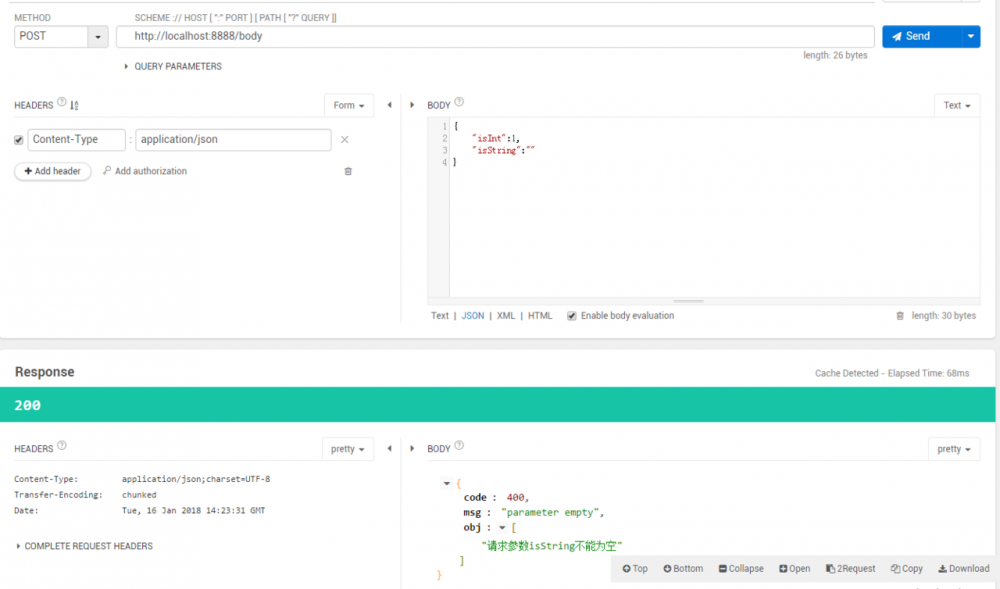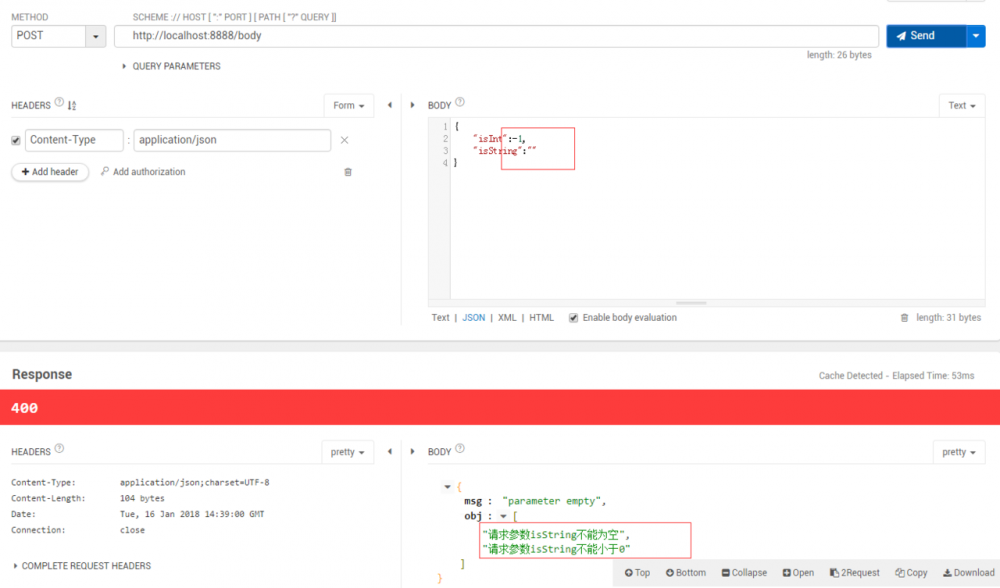Spring AOP 实现“切面式”valid校验
why:
为什么要用aop实现校验?
answer:
spring mvc 默认自带的校验机制 @Valid + BindingResult, 但这种默认实现都得在Controller方法的中去接收BindingResult,从而进行校验.
eg:
if (result.hasErrors()) {
List<ObjectError> allErrors = result.getAllErrors();
List<String> errorlists = new ArrayList<>();
for (ObjectError objectError : allErrors) {
errorlists.add(objectError.getDefaultMessage());
}
}
获取errorlists。这样实现的话,每个需要校验的方法都得重复调用,即使封装也是。
可能上面那么说还不能表明spring 的@Valid + BindingResult实现,我先举个“栗子”。
1. 栗子(旧版本)
1.1 接口层(IDAL)
eg: 简单的POST请求,@RequestBody接收请求数据,@Valid + BindingResult进行校验
- httpMethid: POST
- parameters:@RequestBody接收请求数据
- valid:@Valid +BindingResult
@ResponseBody
@PostMapping("body")
public ResponseVO bodyPost(@RequestBody @Valid TestVO body,BindingResult result){
//校验到错误
if (result.hasErrors()) {
List<ObjectError> allErrors = result.getAllErrors();
List<String> lists = new ArrayList<>();
for (ObjectError objectError : allErrors) {
lists.add(objectError.getDefaultMessage());
}
return new ResponseVO(HttpStatus.BAD_REQUEST.value(), "parameter empty", lists);
}
return new ResponseVO(HttpStatus.OK.value(), "bodyPost", null);
}
1.2 实体(vo)校验内容
@Valid + BindingResult的校验注解一大堆,网上一摸就有的!
public class TestVO {
@Getter
@Setter
@Min(value = 0,message = "请求参数isString不能小于0")
private Integer isInt;
@Getter
@Setter
@NotBlank(message = "请求参数isString不能为空")
private String isString;
}
1.3 结果测试

]
2. aop校验(升级版)
可以看到若是多个像bodyPost一样都需要对body进行校验的话,那么有一坨代码就必须不断复现,即使改为父类可复用方法,也得去调用。所以左思右想还是觉得不优雅。所以有了aop进行切面校验。
2.1 接口层(IDAL)
是的!你没看错,上面那一坨代码没了,也不需要调用父类的的共用方法。就单单一个注解就完事了:@ParamValid
@ParamValid
@ResponseBody
@PostMapping("body")
public ResponseVO bodyPost(@RequestBody @Valid TestVO body,BindingResult result){
return new ResponseVO("bodyPost", null);
}
2.2 自定义注解(annotation)
这个注解也是简简单单的用于方法的注解。
@Target(ElementType.METHOD)
@Retention(RetentionPolicy.RUNTIME)
public @interface ParamValid {}
2.3 重点!切面实现(Aspect)
切面详解:
- @Before: 使用注解方式@annotation(XX),凡是使用到所需切的注解(@ParamValid),都会调用该方法
- JoinPoint: 通过JoinPoint获取方法的参数,以此获取BindingResult所校验到的内容
- 迁移校验封装: 将原先那一坨校验迁移到Aspect中:validRequestParams
- 响应校验结果:
- 通过RequestContextHolder获取response
- 获取响应OutputStream
- 将BindingResult封装响应
@Aspect
@Component
public class ParamValidAspect {
private static final Logger log = LoggerFactory.getLogger(ParamValidAspect.class);
@Before("@annotation(paramValid)")
public void paramValid(JoinPoint point, ParamValid paramValid) {
Object[] paramObj = point.getArgs();
if (paramObj.length > 0) {
if (paramObj[1] instanceof BindingResult) {
BindingResult result = (BindingResult) paramObj[1];
ResponseVO errorMap = this.validRequestParams(result);
if (errorMap != null) {
ServletRequestAttributes res = (ServletRequestAttributes) RequestContextHolder.getRequestAttributes();
HttpServletResponse response = res.getResponse();
response.setCharacterEncoding("UTF-8");
response.setContentType(MediaType.APPLICATION_JSON_UTF8_VALUE);
response.setStatus(HttpStatus.BAD_REQUEST.value());
OutputStream output = null;
try {
output = response.getOutputStream();
errorMap.setCode(null);
String error = new Gson().toJson(errorMap);
log.info("aop 检测到参数不规范" + error);
output.write(error.getBytes("UTF-8"));
} catch (IOException e) {
log.error(e.getMessage());
} finally {
try {
if (output != null) {
output.close();
}
} catch (IOException e) {
log.error(e.getMessage());
}
}
}
}
}
}
/**
* 校验
*/
private ResponseVO validRequestParams(BindingResult result) {
if (result.hasErrors()) {
List<ObjectError> allErrors = result.getAllErrors();
List<String> lists = new ArrayList<>();
for (ObjectError objectError : allErrors) {
lists.add(objectError.getDefaultMessage());
}
return new ResponseVO(HttpStatus.BAD_REQUEST.value(), "parameter empty", lists);
}
return null;
}
}
2.4 测试结果

]
看了上面两种结果,就可以对比出使用Spring AOP 配合@Valid + BindingResult进行校验的优点:
- 去除代码冗余
- AOP异步处理
- 优化代码实现
正文到此结束
热门推荐
相关文章
Loading...











![[HBLOG]公众号](https://www.liuhaihua.cn/img/qrcode_gzh.jpg)

